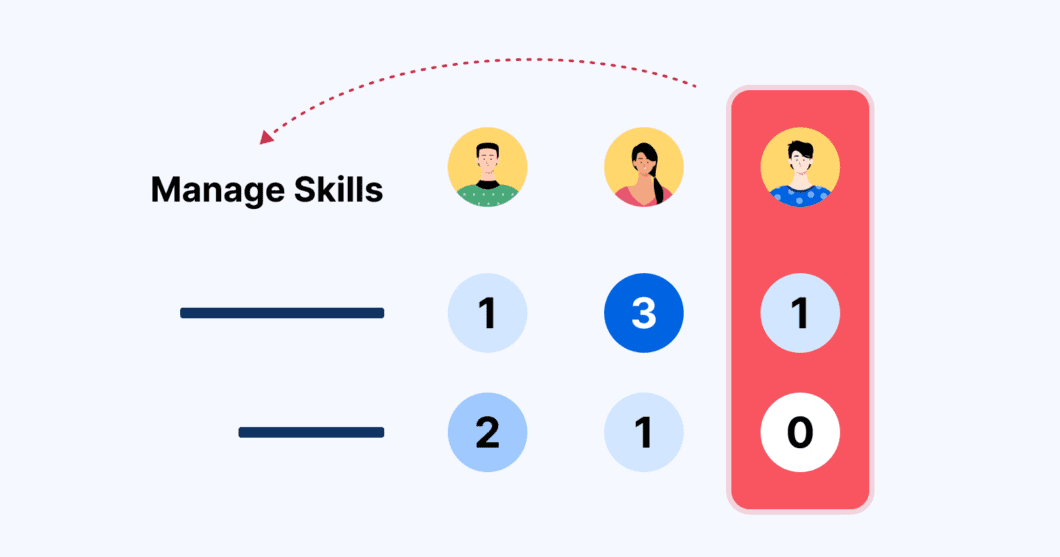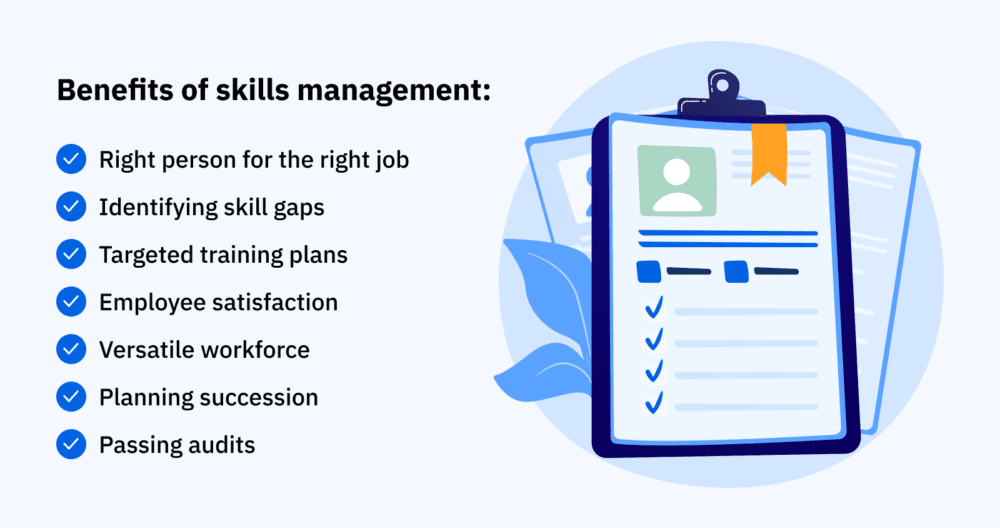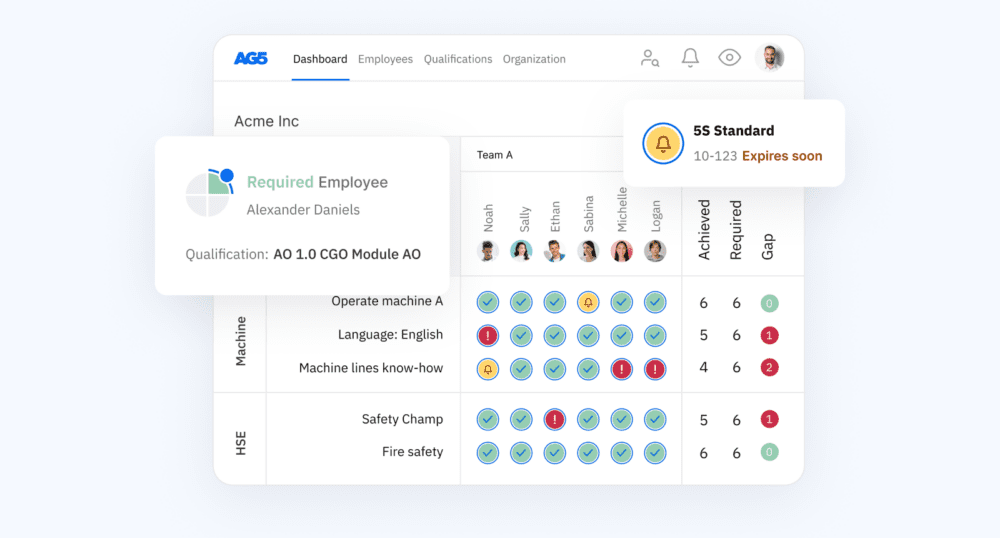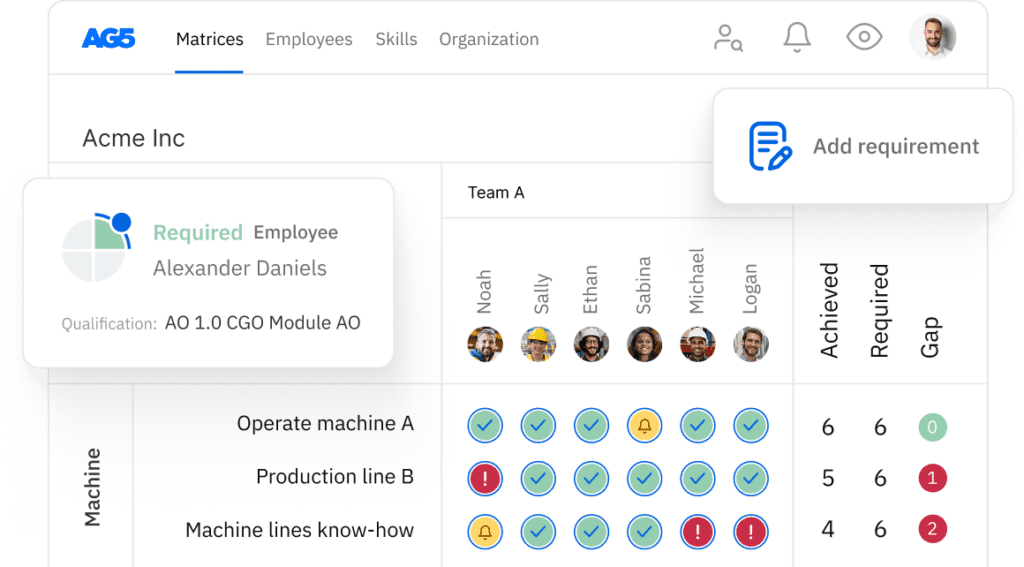Everything you need to know about skills management
In this blog, we’ll take a look at how skills management can benefit your team, how to implement it and pitfalls to avoid when doing so.

Your organization’s success largely depends on your employees’ skills, qualifications, and talents. This means you’ll need a method of tracking them, so you can be sure that they are getting the necessary training – and earning the right certifications – to stay on top of their game.
That method is known as skills management – and in this blog, we’ll take a look at how it can benefit your teams, how to implement a skills management strategy, and pitfalls to avoid when doing so.
Finally, we’ll provide you with an introduction to AG5, a skills matrix software that helps organizations across industries close the skill gap.
What is skills management?Copied
Skills management is the process of mapping and tracking your employees’ skills, qualifications, and certifications. [1]
This process means getting to know and understand more about their skills and competences, and how you can then assign them to jobs not only to optimize your operational processes, but also to boost their job satisfaction levels.
In implementing a skills management strategy, you’ll create profiles that contain information regarding an employee’s range of skills, knowledge, qualifications, and certifications, and experience. You’ll also develop a way to visualize these profiles.
This will enable you to determine whether someone is able – or qualified enough – to perform a certain task or fulfill a given role.
What industries use skills management?Copied
Organizations across all industries can benefit from skills management. However, we’ve noticed that it is especially beneficial for industries that rely on highly skilled positions that require specific qualifications or certifications.
These industries could include the following:
- Automotive
- Aerospace
- Manufacturing
- Energy
- Logistics
- Engineering
- Healthcare
How can skills management benefit your team?Copied
Let’s take a look at a few of the ways in which an effective skills management can benefit your organization.
1. Finding the right person for the right job
Skills management allows you to develop clear oversight over the skills, qualifications, and certifications your employees possess. This means you’ll be able to quickly find employees who are qualified to perform specific jobs or roles.
2. Identifying skill gaps
Skills management doesn’t only focus on the skills your employees have – it also shines the spotlight on those they need to adequately perform their jobs. This includes certifications that may be expiring, or necessary training that is required. Once you have identified these skill gaps, you can take steps to close them.
3. Developing targeted training plans
Skills management allows you to guide staff more effectively in their professional development. With a clear overview of the skills, competencies, and qualifications your organization needs, you can much more easily create targeted training, reskilling, or upskilling plans.
4. Improved employee satisfaction
Studies show that satisfied employees are 13% more productive. They also result in higher retention rates [2]. Your skills management strategy will help you boost employee satisfaction by enabling you to match employees and roles to which they are well-suited.
You’ll also be able to give employees more control over where and how they professionally develop. Both are important factors in employee satisfaction.
5. A more versatile workforce
Once you begin consistently tracking employees’ skills and competencies, you’ll understand exactly what your employees of capable of doing. You’ll also have developed training plans that give your employees ample opportunity to improve. The result will be a workforce that is highly versatile and agile, and that is able to adapt quickly to new technologies, market shifts, or other changes that may otherwise cause production delays or slowdowns. [3]
You can read our article, “The benefits of workforce versatility,” to learn more about the importance of employee flexibility and agility.
6. Finding replacements or planning succession
Because you have mapped your employees’ skills, you’ll now be able to quickly and easily find replacements for employees out sick, or successors for roles, should an employee leave the company. This will help reduce operational downtime and keep your organization and teams productive.
7. Passing audits
Audits are a necessary – and often mandatory – part of any organization’s operations. Preparing for them, however, can be stressful – especially if they are external audits.
The right skills management strategy will ensure that your employees skills, qualifications, and certifications are up to date, compliant, and audit-ready.
Want to learn more about audit preparation? Read our article, “6 tips for wowing your auditors.”

How to implement skills managementCopied
A skills management strategy is more about an attitude and culture shift. This means there is no hard rules for getting started. That said, there are several steps you can take to lay a foundation for effective skills management in your organization. Let’s take a look.
- Assess your organization’s needs. Identify the skills, qualifications, certifications, and roles that are critical for your organization’s success.
- Develop a framework. Create a framework that outlines the skills, knowledge, qualifications, and certifications your employees have and need. One way to do this is by creating a skills matrix.
- Conduct a skill gap analysis. Use your skills matrix to identify skill gaps in your organization or teams. This is achieved by conducting a skill gap analysis.
- Training plans. Develop targeted training programs based on your skill gap analysis that will help reskill or upskill your existing employees.
- Recruitment initiatives. Create job descriptions and develop recruitment processes that focus on the skills your organization needs.
- Succession planning. Identify potential successors for key roles, then create career development plans that are aligned with your organization’s needs.
- Performance alignment. Incorporate the skills, qualifications, competencies, and certifications your employees need into performance metrics and evaluations.
- Monitor and evaluate. Skills management hinges on consistency. You’ll need to constantly fine-tune your skills management strategy to ensure that it is current with new technologies, industry trends, or market shifts.
Pitfalls to avoid when starting with skills managementCopied
Here are a few common pitfalls to be aware of when starting with skills management:
- Lack of clear objectives. Failing to define specific goals and objectives can result in a vague approach to skills management that is both inefficient and ineffective.
- Ignoring employee input. An effective skills management strategy requires employee buy-in. Without it, you’ll notice a lack of engagement, resistance to change, and a disconnect between organizational and individual goals. Make sure to provide ample opportunity for your employees to provide feedback on your skills management strategy.
- Lack of leadership support. Skills management starts at the top. You’ll need to ensure that business leaders and managers endorse and are directly involved with your skills management strategy.
- Focusing solely on technical skills. Technical skills are important, but so are essential soft skills, such as communication and leadership abilities. Make sure you’re paying attention to both when implementing your skills management strategy.
- Treating skills management as a one-time activity. Viewing skills management as a one-time project rather than an ongoing process will result in missed opportunities for improvement and long-term success.
Take skills management to the next level with AG5Copied
AG5 offers plug-and-play skills management software, meaning you can extract all the information from your old Excel spreadsheets and move it to a centralized location.
AG5 offers a multitude of features and functions that make skills management even easier and more efficient. Together, they allow you to:
- Enter updates and training results from the shop floor in real time
- Build ideal teams for projects – categorizing and filtering potential team members by expertise, proficiency level, and experience
- Configure notifications for individuals, groups, or qualifications
- Find qualified replacements quickly and easily to retool production lines
- Find the best replacements for employees off sick or on vacation in a single search
- Map the skills and expertise at other sites
- Replicate organizational structures and link employees to skills and qualifications
- And much more
Want to see what this would look like in practice? Schedule a free, live, 15-minute demo for a customized look at how your organization could use AG5.

FAQs Copied
-
Why is skills management important?
-
How can skills management improve talent acquisition?
-
How does skills management benefit employee engagement?
-
How does skills management support organizational agility?
Sources Copied
- Change view: Table
-
APA
| # | Source title | Description | Publication | Retrieved | Source URL |
|---|---|---|---|---|---|
| 1 | 6 Reasons Why You Need Skills Management Software For Effective Reskilling | eLearning Industry | - | April 18, 2024 | https://elearningindustry.com/.. |
| 2 | Happy workers are 13% more productive | University of Oxford | - | April 18, 2024 | https://www.ox.ac.uk/news/2019.. |
| 3 | Taking a skills-based approach to building the future workforce | McKinsey | - | April 18, 2024 | https://www.mckinsey.com/capab.. |
Author Copied
Revisions Copied
Update reason: Added sections, refreshed content, added sources, added FAQ
Written by: Rick van Echtelt
Copy edited by: Adam Kohut

